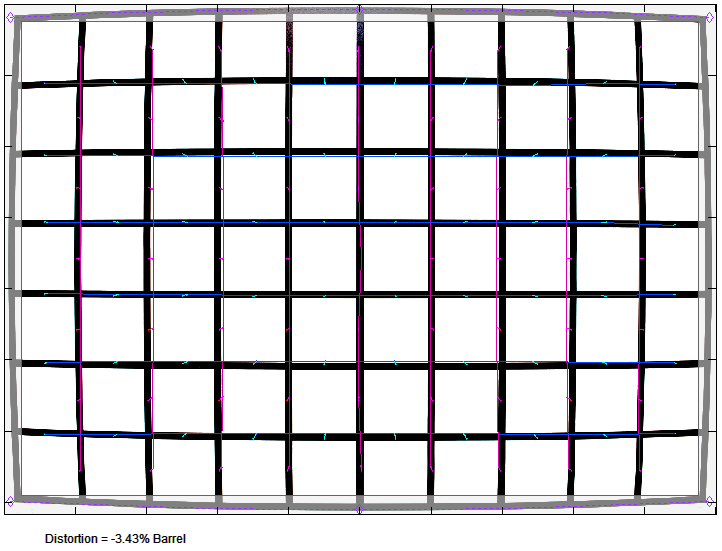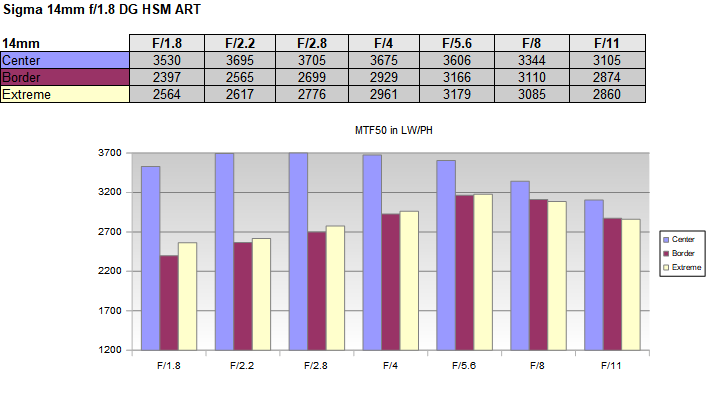|
Sigma 14mm f/1.8 DG HSM ART (Canon) - Review / Test - Analysis |
|
Lens Reviews -
Canon EOS (Full Format)
|
|
Page 2 of 3

Distortion
The Sigma 14mm f/1.8 HSM DG ART produces heavy image barrel distortions (3.4%). This may be normal for a zoom lens but is a little higher than what we expect from a prime lens really. For comparison - the Canon EF 14mm f/2.8 USM L II generates just 1.7% here.

Vignetting
A 14mm lens is doomed to produce a substantial amount of light falloff (also due to "natural vignetting"). However, despite its large aperture this issue is fairly well controlled which surely relates to its immense front element. Of course, ~2.6EV (f-stops) are still very noticeable at f/1.8 but the vignetting is much reduced at f/2.2 already and it's barely more than 1EV at f/2.8. At f/4 there's nothing to complain about really.

MTF (resolution) on the EOS 5Ds R (at 50 megapixels)
Unsurprisingly the resolution is very high in the image center even at f/1.8. The "near" center is also pretty good at fully open aperture and superb between f/4 and f/5.6. However, the lens struggles in the outer image field. The borders/corners are soft at f/1.8 and improve only marginally at f/2.2. When stopping down to f/2.8 the results are fairly Ok. The sweet spot/range is between f/4 and f/8 with good to very good corners. Diffraction has a higher impact from f/11 onward.
The centering quality of the tested lens was very good. The field curvature is substantial at f/1.8 but improves when stopping down.
Please note that the MTF results are not directly comparable across the different systems!
Below is a simplified summary of the formal findings. The chart shows line widths per picture height (LW/PH) which can be taken as a measure for sharpness.
If you want to know more about the MTF50 figures you may check out the corresponding Imatest Explanations

MTF (resolution) at 21 megapixels
Many readers are still using DSLRs with a more moderate resolution of 21mp. The lens quality requirements are somewhat relaxed on such a camera. In this scope, the overall quality is quite usable at f/1.8 already and it steadily improves the more you stop down. The peak is reached at f/5.6 with a tack sharp quality across the image field.
Please note that the MTF results are not directly comparable across the different systems!
Below is a simplified summary of the formal findings. The chart shows line widths per picture height (LW/PH) which can be taken as a measure for sharpness.
If you want to know more about the MTF50 figures you may check out the corresponding Imatest Explanations

Chromatic Aberrations (CAs)
Lateral CAs are comparatively low at around 1px on the average at the image corners (at 50mp). This is pretty impressive at this resolution.

Bokeh
There is usually not much to tell about when it comes to bokeh and ultra-wide lenses. With conventional lenses, you have to select a very close focus distance for a pronounced bokeh effect. The Sigma is a little different here and it does a surprisingly good job for a lens in this class. Out-of-focus highlights aren't perfectly clean - they never are with lenses featuring aspherical elements - but they are much better than expected. There's also just a minor outlining effect.
 Ultra-wide angle lenses tend to have rather terrible highlight distortions in the corners but, again, the Sigma is superior to most in this respect. The onion-like substructure is getting more pronounced here though.
Ultra-wide angle lenses tend to have rather terrible highlight distortions in the corners but, again, the Sigma is superior to most in this respect. The onion-like substructure is getting more pronounced here though.
 The general blur quality is also quite pleasing as you can see below:
The general blur quality is also quite pleasing as you can see below:

|